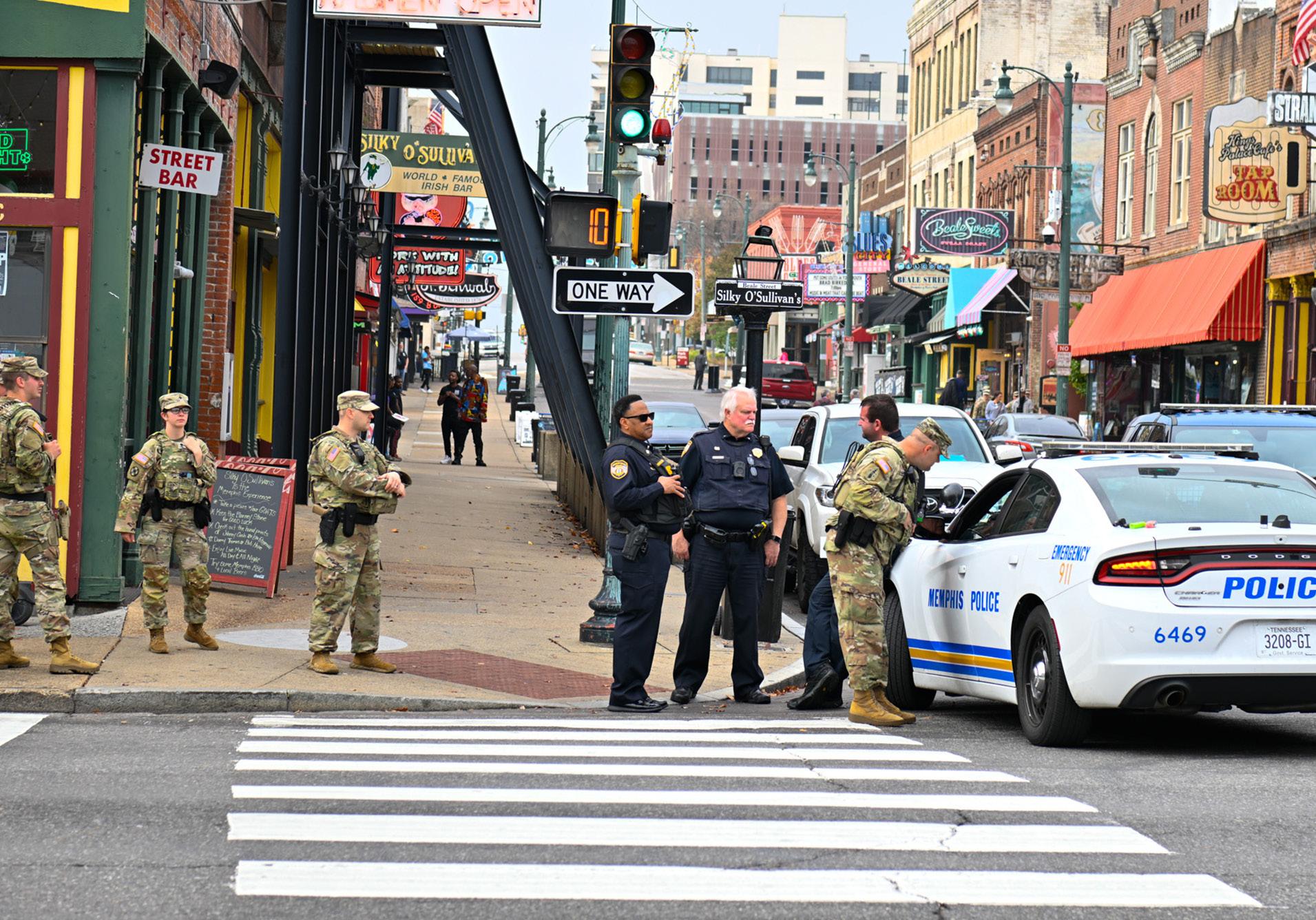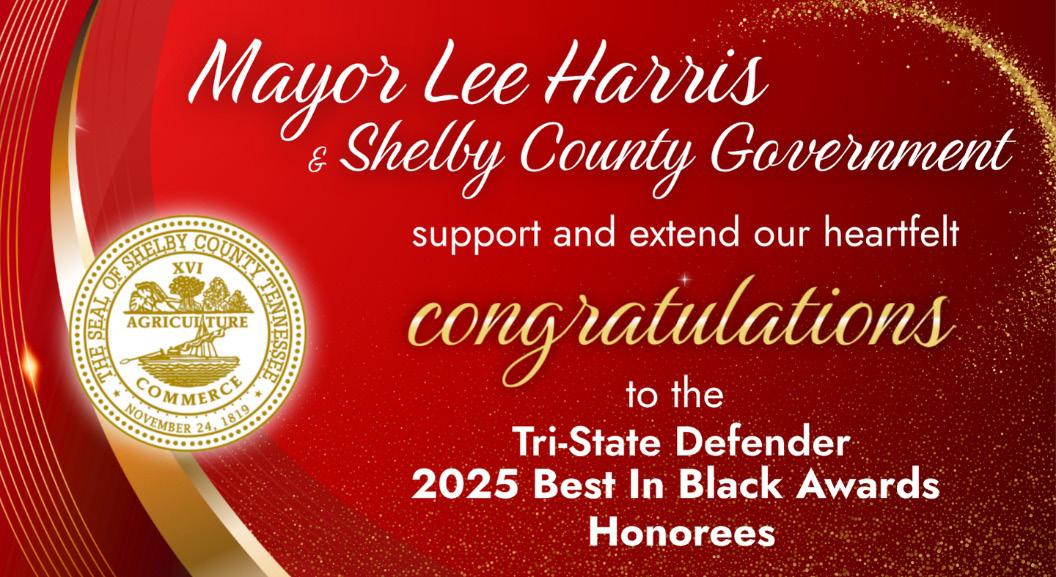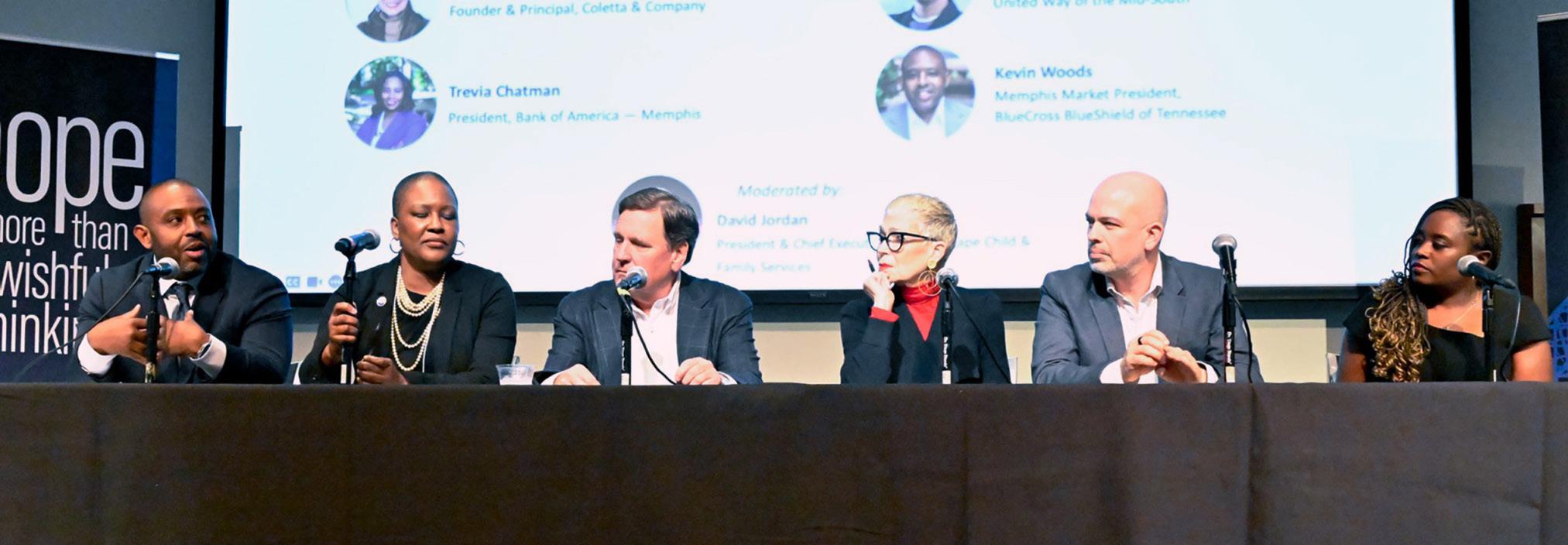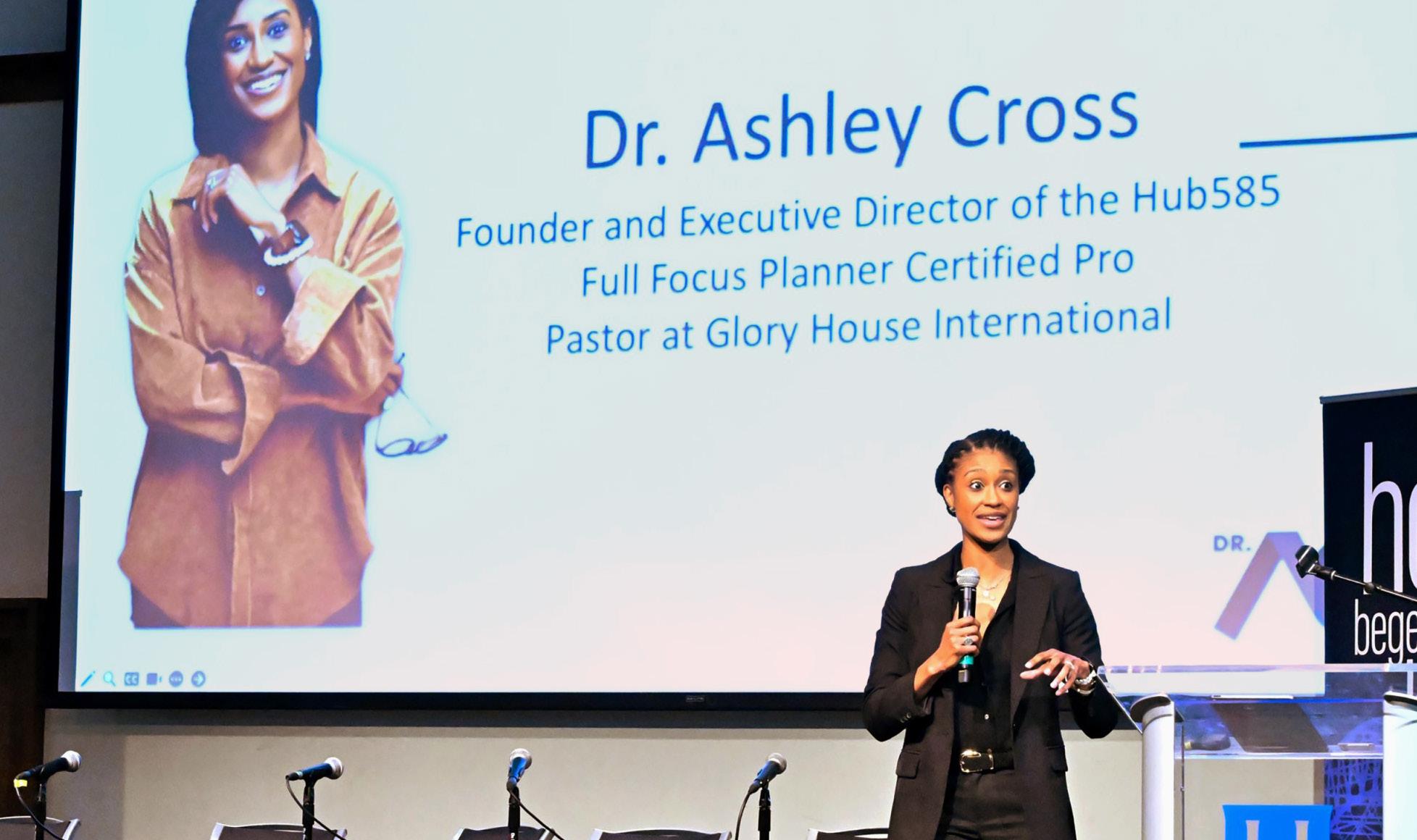

DEFENDER







By Lee Eric Smith TSD Contributing Writer
A Nashville judge has ordered Gov. Bill Lee to halt the National Guard deployment in Memphis, ruling that the governor violated Tennessee law when he unilaterally sent troops into the city without legislative approval or a local request — a sweeping rebuke that immediately sent political shockwaves through the state.
In a sharply written 37-page order issued late Monday, Davidson County Chancellor Patricia Head Moskal granted a temporary injunction blocking further Guard activity under what she called an “unlawful deployment.”
She concluded that neither the Tennessee Constitution nor state statute grants the governor the unilateral authority to use military forces for civilian policing — the argument made for weeks by the seven elected officials who sued Lee.
But as the ink dried on the ruling, a new question surfaced — one with profound constitutional stakes: If Gov. Lee broke the law to send the Guard into Memphis, will he obey the law now that a judge has ordered him to pull them out?
That question hangs over the state’s political landscape as the governor weighs whether to comply, appeal, or — as some fear — push deeper into confrontation with the courts.
Moskal’s ruling is both sweeping and plainspoken. Her most forceful conclusion: “The governor did not follow the law.” She found that:
• Tennessee law requires a request from a local government before the Guard can be used for civilian law en-
forcement in non-emergency circumstances.
• There was no rebellion or invasion that could trigger unilateral gubernatorial authority.
• The General Assembly — not the governor — must approve the use of the state militia for policing Tennessee citizens.
That ruling immediately vindicated the central argument of the plaintiffs — Shelby County Mayor Lee Harris, Memphis City Councilman JB Smiley Jr., State Rep. G.A. Hardaway, State Rep.
Gabby Salinas, State Sen. Jeff Yarbro, and County Commissioners Henri E. Brooks and Erika Sugarmon. The injunction does not take effect immediately; Lee has five days to appeal.
But the ruling itself is historic — the first time a Tennessee court has blocked a governor’s use of the National Guard on constitutional grounds in more than a century.
Plaintiffs reacted swiftly, praising the ruling as a win for the rule of law — and for Memphis.
“Pleased that the Court has issued a fa-

vorable decision on our motion for a temporary injunction,” Mayor Harris wrote on X (formerly Twitter). “This is a positive step toward ensuring the rule of law applies to everyone — including everyday Tennesseans and even the Governor.”
“The court has granted our temporary injunction.” Smiley wrote on Facebook. “The National Guard is being ordered to leave Memphis. I will never stop fighting for the people of our county and the rule of law.”
NewsMax commentator Todd Starnes, referring to Harris and Smiley as “Democrat overlords,” wondered on X: “Will the Democrats also demand that the missing children recovered by the task force be returned to the human traffickers?”
“Todd,” Harris responded on X, “if we are going to have a country, we have to have laws and those laws must be respected by everyone, from Governor to everyday Tennessean. What’s the point if our laws aren’t going to be enforced?”
Lee’s office has not yet issued a statement, as of Tuesday at 12 p.m. But on Oct. 29, Lee indicated expanding the deployment, not reducing it, telling reporters: “We will continue to deploy additional resources where needed.”
Memphis Mayor Paul Young, not

included in the suit, confirmed that his office had been informed that more troops were on the way.
Hardaway, also a plaintiff, called Lee’s announcement of more troops coming to Memphis “arrogance” in an interview with the TSD.
“He’s doubling down on the deployment — even while the matter was still in court,” Hardaway said. “It shows he has no intention of bringing this to the Legislature.”
When asked whether he believed the governor would honor the court order, Hardaway was frank: Like anyone else, defiance of a court order is legally considered ‘contempt of court.’
“It might look like a fine. It might look like incarceration. I don’t know,” Hardaway said. “But the governor has got to do his job. I would hope he respects his own oath of office.”
He added that Tennessee’s Republican legislators — who campaign on “law and order” — must now decide whether those words apply to the governor, too.
“Now is as good a time as any for them to show it,” Hardaway said.
Harris has repeatedly stated that the Guard’s presence had caused a surge of low-level arrests and court congestion — something Judge Moskal referenced
in her analysis.
Harris showed data demonstrating:
• Bookings nearly doubled for the week of Oct. 6–12 compared to the same week last year
• Misdemeanor arrests rose sharply, suggesting an expanding dragnet
• Bail hearings doubled, straining judicial capacity
• Overcrowding worsened at the already-stressed 201 Poplar complex
“These are quantifiable local consequences,” Harris said. “This is not theoretical.”
Hardaway echoed the point: “(The deployment is) wasting hundreds of millions of dollars. For what? To address the symptoms of crime — not the causes.”
Hardaway argued that the same funds could have supported preventive measures like educational opportunities, mental health care, workforce development, entrepreneurship and re-entry programs.
“When people have real options, they don’t choose crime,” he said. “Military occupation offers no long-term solutions.”
U.S. Rep. Steve Cohen, (D-TN), whose district includes Memphis, issued a statement in support of the judge’s ruling.
“I have said repeatedly that I believe
the coordinated surge in federal and state law enforcement to address crime in Memphis is useful and having a positive impact, but there is no need for National Guard troops. Deploying the military to the streets of our city is unnecessary, counterproductive, and expensive,” Cohen stated.
If Gov. Lee appeals, the case will move to the Tennessee Court of Appeals — and potentially the Tennessee Supreme Court. Hardaway believes the ruling is on firm enough legal ground to survive scrutiny.
“Look at how long she took to write it. Look at the detail,” Hardaway said of the 37-page document. “It will be very difficult for any appeals court to overturn it.”
But even if the courts reaffirm the ruling, the core dilemma remains: What happens if a governor simply refuses to comply?
That question landed with weight at an October press conference announcing the lawsuit, when the Tri-State Defender asked the plaintiffs who would enforce a ruling against the governor. Democracy Forward attorney Yanis Rodríguez paused before answering.
“This is something we are thinking very deeply about,” she said.


By Lee Eric Smith TSD Contributing Writer
A Davidson County judge’s ruling that Gov. Bill Lee likely acted unlawfully when he ordered the deployment of the Tennessee National Guard to Memphis now enters a new phase.
The governor’s office has said it will appeal the ruling — and that the Guard will remain active in the city while the case moves forward. Press Secretary Elizabeth Lane Johnson wrote in a statement Tuesday afternoon:
“Memphians know their city is facing a violent crime emergency that the state must address, and we’re confident higher courts will ultimately recognize this as well. The State will appeal, and the Tennessee National Guard will continue to operate as part of the Memphis Safe Task Force while the case is on appeal.”
“To date, the Memphis Safe Task Force has made 2,800 arrests, confiscated more than 450 illegal firearms, and located 114 missing children, and there’s no question these public-safety efforts must continue,” the statement concluded.
Johnson’s statement drew immediate push-back from local critics.
At a press conference held in the Shelby County Administration Building on Tuesday, the coalition of city, county and state leaders behind the lawsuit laid out their case: Gov. Lee violated the law when he agreed to deploy troops without a request from local leaders or authorization from the State Assembly.
“On Sept. 15th, Gov. Lee sat in the Oval Office with President Trump and what we saw was dumbfounding and disappointing,” said Shelby County Mayor Lee Harris. “Our hope was that

Gov. Lee would have said to those assembled, ‘Mr. President, Tennessee is a free state, and we have no authority to use the military against Tennesseans.’
“Unfortunately, that did not happen,” Harris continued. “Instead, Gov. Lee agreed to send troops to West Tennessee, even though he knew, or should have known, that that was patently illegal.”
Bolstered by Chancellor Patricia Head Moskal’s 37-page rebuke of the deployment, the plaintiffs framed the issue as bigger than just Shelby County,
and that despite having the law on their side, they are still underdogs in this fight.
“The effect of this wrong-headed and illegal decision has been catastrophic to some of the most important laws and norms of our country,” Lee said. “This is not just about Memphis. This is about the Constitution. This is about whether we are going to follow the laws in the state of Tennessee.
“We’re up against the mightiest of adversaries: The White House and Donald Trump, Gov. Lee, and federal
officials, some of whom are willing to do whatever it takes to satisfy their whimsy of the day,” he added. “But (Moskal’s ruling) is still an important first step.”
Harris framed the legal fight against other occupations in Oregon, Illinois and California, where courts have recently rebuked similar federalized “lawand-order” deployments. “We believe this is the first state action against the unlawful deployment of the military against Americans,” he said.
Memphis City Councilman JB Smiley
“They’re not doing anything. We’re spending millions of dollars to afford the National Guard to simply walk on streets, laugh and play when we have some very pressing issues in this community.”
— JB Smiley
Jr., also a plaintiff in the case, raged against the money being spent on the deployment that would be better spent on solving the root causes of crime that the Memphis Safe Task Force is supposed to fix.
“They’re not doing anything,” Smiley said. “We’re spending millions of dollars to afford the National Guard to simply walk on streets, laugh and play when we have some very pressing issues in this community.
“Instead of wasting dollars on people who don’t wanna be here, who are not impacting our issues in our community, there are some places those dollars can go,” he continued, suggesting infrastructure and education. “How about investing dollars into places that matter to people? We’re wasting time, we’re wasting resources for a political show.”
State Rep. G. A. Hardaway echoed the sentiment.
“You could put that same money to work preparing employees with hard-

skill training or soft-skill training, or providing funding so entrepreneurs can launch their businesses,” said Hardaway, also a plaintiff. “That’s how you reduce crime — by creating real options, not by sending in troops.
“We need to go into the prevention and intervention business and prevent crime,” he added. “We can’t just keep spending money on an occupation that offers no real long-term solutions.”
Andy Sher of The Tennessee Journal reports that some GOP lawmakers are having informal conversations about granting Lee the authority he would need to maintain the deployment. Sher’s reporting attributes an anonymous GOP lawmaker. TSD has not independently confirmed the claim.
In fact, Hardaway says that quietly, his colleagues are stewing over Lee’s use of executive power and they don’t want to be involved in a political drama between Lee and Memphis.
“The legislators that I’ve talked to, they don’t want to be in Memphis’ mess,” Hardaway said. “They get tired of being pulled into Memphis and Shelby County issues that have nothing to do with them and really nothing to do with state affairs.”
Hardaway said his colleagues are thinking about what happens when the political pendulum swings the other way.
“A lot of Republicans probably won’t come out and say it, but yeah they’ve got concerns too,” Hardaway said of the precedent Gov. Lee is setting. “Every

Comcast congratulates the Best in Black Award winners and salutes the Tri-State Defender on 74 years of excellence, impact and community inspiration.
precedent that we accept now will apply when we have a Democratic-led government also. Either way, they know this is one big power grab.”
Smiley warned that the creep of authoritarianism is everyone’s fight.
“(Gov. Lee’s actions are) deeply troubling. Not just for those who take oaths to uphold the laws of this state,” Smiley
said. “It’s deeply troubling for everyone who calls this community home. We have to stand up, we have to push back.
“Because if we allow the government to continue to abridge our rights, the question you should be asking yourself is: When are they coming for me?”



“We often see more seniors in need than we have resources to help. Each day, we meet elders who want to remain in the homes they built their lives in but can’t afford the repairs to do so safely.”
— Leah Wooten
Without new program models and funding strategies, communities will struggle to keep pace with serving one of the fastest-growing populations in recent U.S. history.
By Judith Black Moore
Just in case you haven’t noticed, America is getting older fast. Every day, about 11,400 people turn 65. In less than five years, all Baby Boomers will be 65 or older. By 2034, older adults will outnumber children for the first time in U.S. history, according to the Census Bureau.
Yet the share of philanthropic dollars directed toward aging services has barely shifted in two decades. Less than 2 percent of U.S. foundation giving, by most estimates, goes to aging services. And although one-fifth of Americans are 65 or older, only about 6 percent of U.S. nonprofits primarily serve seniors. The lack of investment is not only a budget issue, but it also reflects how society assigns value. Youth is treated as promise. Aging is treated as obligation. When donors make choices, causes that support young people are usually prioritized over causes that support older adults.
As the senior population grows faster than the resources available to support it, a crisis is unfolding. Across Memphis and the country, older adults live on fixed incomes while the cost of home repair costs climbs. Many are Black homeowners in neighborhoods once redlined. As these neighborhoods

gentrify, rising property taxes and deferred repairs are pushing out residents who held their communities together.
Leah Wooten, founder of Reaching Back, sees the reality up close. Her organization helps seniors age with dignity, confidence and safety through compassionate care, home repair help, food support and chances to connect.
“I have been in real estate 35 years and what I kept finding when I walked into seniors’ homes is that they were choosing between taking care of repairs and buying medicine,” she said.
Food insecurity deepens the strain. Since 2001, food insecurity among seniors has doubled, according to Feeding America. The nonprofit response is still a patchwork of church ministries, volunteer teams and seasonal drives because sustainable funding is limited.
“We often see more seniors in need than we have resources to help,” Wooten said. “Each day, we meet elders who want to remain in the homes they built their lives in but can’t afford the repairs to do so safely.”
Organizations like Reaching Back operate as quiet extensions of the public health system. They patch roofs to stop leaks, deliver groceries to avert
malnutrition and complete tasks that delay nursing home placements. They save public dollars by doing relational work that the government can’t or won’t do — but they do it with small staffs and modest budgets.
In a society focused on equity and inclusion, aging is too often left out of the conversation. In grant language, “underserved populations” tends to refer to youth, women or families. Yet aging is the one demographic people will eventually join.
“Seniors don’t just need help; they need respect, connection and the chance to stay in the homes where they raised families,” Wooten said. “A simple repair or simply showing up can restore safety, dignity, confidence and hope.”
Restoring dignity will require more than scattered funding. It will require innovation in how we think about programs and how we measure impact. What if innovation included maintaining what already works, like neighborhood-based aging support that prevents displacement? What if impact included measuring dignity, stability and years lived at home?
Wooten believes equity is the place to start — ensuring seniors are fully seen and supported with the same urgency given to younger populations.
“Small things matter like fixing a leaky roof that harms health or repairing a broken handrail that makes a senior fear falling, or consistent companionship to prevent loneliness and the feeling of being forgotten,” she said. “Innovative investments can support this and preserve history, strengthen families and allow seniors to age in place.”
Could one pathway to equity involve intergenerational solutions? What if senior-serving and youth-serving nonprofits collaborated to support both generations through shared programs? Young people could learn to make minor repairs, offer tech help and provide companionship, while seniors offer mentorship, grounding and wisdom. Funders could then invest in single programs that serve both ends of the age spectrum, creating a more equitable and sustainable model for closing funding gaps.
America’s future will depend, in part, on whether nonprofits can innovate to support a rapidly growing aging population. Failing to act will leave us all affected by our own neglect.
But for now, there are organizations like Reaching Back that understand senior equity is not about sympathy. “They’re showing us how equity really looks — resilient, resourceful and wanting to be fully seen,” Wooten said.
“We are making that possible for seniors by ensuring they can walk safely up their own steps again and enjoy the peace of mind that comes with a warm, dry home.”
This work is more than repairing houses or distributing food. It is a collective commitment to honor every person’s right to age with dignity on their own terms in a community that refuses to let them disappear. True equity demands that we create the conditions for older adults to live with safety, purpose and belonging. In doing so, we uphold their humanity and safeguard the kind of future we want to inherit. For information about Reaching Back, visit: https://reachingbackinc.org.
By Black Press USA
Onyx Impact has released its eye-opening BlackOut Report which reveals that the efforts to derail Black progress are not merely historical footnotes but present-day threats. In just the past eight months, there have been 15,723 distinct impact points, each representing a direct attack on Black opportunities, lives, or histories.
Over this period, the report identifies 14,072 instances of distortion. On Make It Plain with Rev. Mark Thompson, Onyx Impact Executive Director Esosa Osa said:
“Distortion is by far the largest component of our database, with over 14,000 examples of swapping out evidence for ideology. This is fundamentally rewriting, grants, rewriting, all types of evidence distorting data sets. You are erasing that data, you’re hiding the proof of discrimination, you’re hiding the proof of inequality and, therefore, you’re preventing any type of remedy.”
The BlackOut Report highlights 1,362 examples of erasure during the eight month period.
“When we talk about erasure, we’re talking about the erasure of Black heroes from government websites. We’re talking about the statues of Black history not just being removed, but being replaced by Confederacy statues [and] the banning of nearly 600 books by Black authors,” said Osa.
The BlackOut Report also exposes 289 efforts to suppress African American influence.
“Suppression is the active silencing of voices that could challenge the narrative. We’ve documented 63 government


threats and investigations—strategies specifically designed to ensure institutions and individuals think twice before speaking up, effectively muting calls for accountability and justice,” Osa said.
“We are seeing $3.4 billion, what ended up being $3.4 billion at least in investment slashed to Black communities, right under this guise, this smoke screen, this Trojan horse of DEI,” Osa said.
The BlackOut Report also identifies
cuts including:
• $9.4M in sickle cell disease research
• $68.5M for projects that prevent flooding in predominantly African American neighborhoods
• $31M to address high asthma rates for African American children and reduce air pollution in African American communities
• 16 NIH grants totaling $37M for research into disproportionate colon and prostate cancer in African Ameri-
• $23.7M to fix unsafe drinking water and reduce childhood lead exposure in African American communities
• $210M in grant funding to HBCUs, $11M to Howard University, more than $2.9M of funding for a center at Morehouse College focusing on improving the health of Black pregnant women, as was $1.2M of funding to increase Black enrollment in the marine sciences at Hampton University.
“Distortion is by far the largest component of our database, with over 14,000 examples of swapping out evidence for ideology. ... You are erasing that data, you’re hiding the proof of discrimination, you’re hiding the proof of inequality and, therefore, you’re preventing any type of remedy.” — Esosa Osa

leaders to chart pathways for progress by turning hope into the framework for strategies, policies and programs that move the city forward
By Judith Black Moore TSD Contributing Writer
More than 400 Memphians filled the University Center at the University of Memphis for the first Memphis Hope Summit, an all-day gathering Thursday, Nov. 13, designed to place the science of hope at the center of planning the city’s future.
Presented by Agape Child and Family Services in partnership with the City of Memphis, Shelby County and a cross-section of nonprofit, faith and government stakeholders, the summit focused on research from the Hope Research Center at the University of Oklahoma. Workshops and presentations centered on how the science of hope can be applied in practice.
The science of hope was developed by Chan Hellman, PhD, at the University of Oklahoma’s Hope Research Center, one of the presenters at last week’s Hope Summit. He defines hope not as emotion or optimism but as a measurable cognitive skill that determines whether people, especially youth, can succeed.
In his research involving more than 2,000 studies across education, mental health, child welfare and juvenile justice, hope was identified as the strongest predictor of positive outcomes. It is built on three components: goals (having something to work toward), pathways thinking (seeing ways to get there), and agency (the belief you can take action).
When paired with trauma-informed neuroscience which explains how stress and adversity affect the developing brain, studies show hope as a powerful, evidence-based tool that helps disrupt

cycles of trauma and moves individuals and communities toward thriving.
Using her own childhood experiences to illustrate the difference between survival and hope, Oklahoma First Lady Sarah Stitt opened the summit with a direct explanation of why hope science matters in communities shaped by trauma.
“Survivorship is not a hope mentality,” she said. “So many people in your community don’t know anything different (than survivorship). When a child has only lived in a survivor environment, they don’t know their life can be different. They don’t feel the power to make that change from just surviving to having hope because surviving is just making it from one minute to the next, one day to the next. That is not hope.”
Other sessions focused on justice, civic leadership, education, families and steps toward cultural transforma-
tion. Participants examined how to confront despair, identify barriers and build practical pathways toward a more hopeful Memphis.
Ashley Cross, EdD, founder and executive director of The Hub585, which works to move families from trauma to belonging, told the audience: “Hope is this beautiful marriage between power and belonging.”
For David Jordan, president and CEO of Agape Child & Family Services, the summit represented nearly six years of planning and implementation.
“We’ve worked with experts out of Oklahoma, and we’re already framing our own programs around the principles of hope,” Jordan said. “This is not wishful thinking. Hope is cognitive thinking. It’s about saying, ‘We can be better if we take small steps toward a bigger goal.’”
Jordan said the summit is intended to
drive long-term strategies for trauma-informed programs rooted in hope.
“This is a movement,” he said. “As Memphis leaders, we are saying, this is us — churches, nonprofits, businesses, media — (and) we want to change the narrative of our city. Because if hope wins, Memphis wins.”
Michael Arnold, a lead trainer for AFIRM, a fatherhood program under Families Matter, said building a hope-centered city requires coordinated strategy.
“We are better together,” he said. “I appreciate that this is not a pep rally. We are going to be excited. We are going to be motivated, but we are also going to have a plan.”
Arnold said fathers are facing significant challenges due to the 43-day federal shutdown and other policy shifts impacting daily life. He noted that promoting hope can be difficult
when basic needs are unmet.

“I was talking to a father last night who hadn’t eaten in two days,” he said. “He’s trying to do the right thing. He has kids. He could make money in the wrong way, but he doesn’t want that. Hope for fathers is the opportunity to be a provider, a protector, to show their children something different.”
Arnold added that for hope to take hold “we have to stop letting outside people define our destiny.”
A panel titled Hope Wins, moderated by Jordan, invited city leaders to assess where hope is evident in Memphis and what must change for hope to expand.
Trevia Chatman, president of Bank of America – Memphis, described driving through North Memphis, where she grew up and noticing renewed development.
“I invite people to take a ride through our city,” she said. “Go back to your old neighborhood. We are making changes. Incrementally, yes, but they’re real. In some old neighborhoods, we’ve got cranes in the sky again.”
Kevin Woods, Memphis market president for BlueCross BlueShield of Tennessee, told attendees, “I remain hopeful and optimistic because even though we have big challenges, we have big rooms where people with big hearts want to do big things.”
He also described hope as “not just wishful thinking. It’s vision plus action,” and urged political leaders to embrace risk. “It is okay to get it wrong. In business that’s courageous leadership. In politics it shouldn’t be a career-ender. Own it. Change it. Our people will be better for it.”
Tomeka Hart, president and CEO of United Way of the Mid-South, highlighted Memphis’ ability to respond quickly in crisis.
“With the SNAP crisis, in two days we raised more than a million dollars so families could eat,” Hart said. “That gives me hope. But what keeps me up at night is that it’s episodic. We don’t have a long-term strategy for hope.”
She added: “Hope requires opportunity. We can’t just ask poor people to feel hopeful. Memphis leaders have to make decisions that extend beyond a four- or eight-year term.”

William Dunavant, CEO of Dunavant Enterprises, emphasized literacy as a central pathway to hope and added, “This room is the opportunity. Hope is the goal for the hopeless. I don’t think we’re positive enough about this city. But being positive starts with hope.”
Some leaders said real progress requires naming systemic barriers.
Mauricio Calvo, president and CEO of Latino Memphis, noted how current immigration enforcement efforts are affecting local families.
“I want to be optimistic, but I also have to be authentic,” Calvo said. I ask myself every day ‘how do I tell someone to be hopeful under the current circumstances?’ I see good things in Memphis, but in some areas, we are standing in the same place we were in the 1960s.”
He continued: “It’s okay to be hopeful, but we also have to provide pathways to be hopeful.”
Carol Coleta, founder and principal of Coletta & Company, said Memphis cannot move forward without embracing inclusive leadership and diverse local talent.
“Civic leadership has been well-meaning,” she said, “but the results haven’t taken us where they need to. We haven’t grown in population. We haven’t competed well with cities we compare ourselves to.”
She added: “Everyone has something
to contribute to the success of this city. Inclusive leadership is the path forward. Everyone has agency.”
Returning to the theme of families, Chatman added: “We talk about wrapping our arms around school children, but we can’t forget the mothers and fathers. If we don’t think about adults too, the cycle continues.”
Agape has already incorporated the hope science framework into its work with families and staff. The organization’s goal is to help spread the model across Memphis so that programs, policies and services adopt hope as a guiding principle.
“Our goal,” Jordan said, “is to help Memphis become a model for cities across the country. But Memphis is our center. We’re starting here.”
The summit concluded with a return to its central question: Can Memphis intentionally build a culture of hope?
To Jordan, the answer remains the same:
“Hope wins,” he said. “Memphis wins.”

With the longest U.S. government shutdown over, state officials said Thursday that they are working quickly to get full SNAP food benefits to millions of people, though it still could take up to a week for some to receive their delayed aid.
A back-and-forth series of court rulings and shifting policies from President Donald Trump’s administration has led to a patchwork distribution of November benefits under the Supplemental Nutrition Assistance Program. While some states already had issued full SNAP benefits, about two-thirds of states had issued only partial benefits or none at all before the government shutdown ended late Wednesday, according to an Associated Press tally.
The Tennessee Department of Human Services announced on its website Wednesday, Nov. 12, that it would begin processing partial SNAP payments, following updated guidance from the U.S. Department of Agriculture Food and Nutrition Service to issue 65% of SNAP benefits for November 2025.
The federal food program serves about 42 million people, about 1 in 8 Americans, in lower-income households. They receive an average of around $190 monthly per person, though that doesn’t necessarily cover the full cost of groceries for a regular month.
A spokesperson for the USDA, which runs the program, said in an email Wednesday that funds could be available “upon the government reopening, within 24 hours for most states.” But the agency didn’t say whether that timeline applies to when the money is available to states or when it could be loaded onto debit cards used by beneficiaries.
Upon the reopening of the federal government, TDHS said it will work quickly with USDA to process remain-

ing benefits for SNAP customers.
Tennessee SNAP customers who were originally scheduled to receive their benefits between November 1–12 would see benefits on Wednesday, Nov. 12. Those scheduled to receive benefits after Nov. 12, can expect to receive their partial November SNAP benefit payment on their regularly scheduled date.
Tennessee SNAP recipients can use the One DHS Customer Portal to view the latest case details at https://onedhs. tn.gov/csp
West Virginia, which hadn’t issued SNAP benefits, should have full November benefits for all recipients
by Friday, Gov. Patrick Morrisey said Thursday.
The Illinois Department of Human Services, which previously issued partial November benefits, said Thursday that it is “working to restore full SNAP benefits.” But it won’t happen instantly.
“We anticipate that the remaining benefit payments will be made over several days, starting tomorrow,” the department said in a statement, and that “all SNAP recipients will receive their full November benefits by November 20th.”
Colorado said late Wednesday that it is switching from delivering partial payments to full SNAP benefits. Funds
could be loaded onto electronic benefit transfer cards starting as soon as Thursday, Gov. Jared Polis and the state’s Human Services Department said.
Missouri’s Department of Social Services, which issued partial SNAP payments Tuesday, said Thursday that it is waiting for further guidance from the USDA about how to issue the remaining November SNAP benefits but would move quickly once it gets that.
Federal legislation funds SNAP for a year
The USDA told states Oct. 24 that it would not fund SNAP benefits for November amid the government shutdown. Many Democratic-led states sued to have the funding restored. After judges ruled the Trump administration must tap into reserves to fund SNAP, the administration said it would fund up to 65% of its regular allocations. When a judge subsequently ordered full benefits, some states scrambled to quickly load SNAP benefits onto debit cards during a one-day window before the Supreme Court put that order on hold Friday, Nov. 7.
Meanwhile, other states went forward with partial benefits, and still others issued nothing while waiting for further USDA guidance about the situation. Amid the uncertainty over federal SNAP funding, some states tapped into their own funds to provide direct aid to SNAP recipients or additional money for nonprofit food banks.
The legislation to reopen the U.S. government provides full SNAP benefits not only for November but also for the remainder of the federal fiscal year, which runs through next September.
(Associated Press writers Geoff Mulvihill, David A. Lieb, John O’Connor in Springfield, Illinois; John Raby in Charleston, West Virginia; and Colleen Slevin in Denver contributed to this report.)

By Terri Schlichenmeyer
This week, you plan on acting up. In a good way, of course. You’ll make a cardboard sign and march with others for your beliefs. You’ll shout and dance, walk and make noise. You’ll get into “good trouble” and yes, you might get arrested for it. You do what you need to do to make politicians and others know how you feel and that you mean business. As in the new book, “Black Arms to Hold You Up” by Ben Passmore, you have history at your back.
There was violence just down the street when Ben’s father showed up on his doorstep with two bags of books. He hadn’t been much of a father, so when he started pushing Ben to pay attention to history, Ben wasn’t having any of it.
They argued. Ben’s father hit him in the head with a book — and the next thing he knew, Ben was standing on a street corner somewhere, and there were policemen; nearby was a man named Robert Charles, and the year was 1900. Ben was about to witness a deadly gunfight over Jim Crow laws, Black Code, “Christian Black identity,” and inequality in New Orleans. He ran for safety and landed at the foot of a stage, where activist Marcus Garvey was giving a speech at a Universal Negro Improvement Association (UNIA) rally. Ben ran, and found himself in a church, at Emmett Till’s funeral. He sat in a movie theater and learned about Robert E. Williams, a man whom “both the whites and the
NAACP made… out to be an angry and violent brute.” Ben received a new name to reflect the Republic of New Afrika, and he hid upstairs in a house in Philadelphia, as MOVE fought with police in 1985.
The journey was wild and terrifying, and his eyes were opened. Yes, he wanted liberation, but it could kill him. So could just walking around his neighborhood. Were these things inevitable? He wondered — until his father told him what “Black liberation is really about.”
Your young adults need to know their history. You might need the same. And you both might find some of it inside “Black Arms to Hold You Up.” But there are a few things you need to know first, before you pick it up.
Deeply researched, very thought-provoking, and including a bibliography for more information, this book hits a lot of major points in Black history, many of which today’s schoolbooks don’t tell. Passmore proves that Black activism didn’t start during the Civil Rights Movement, or five years ago, or last year. Such reminders make this book relevant.
Just know this: Violence literally colors every page of this book. It’s relentless. It’s loud and shocking, with illustrations tinted blood-red throughout, which will properly and righteously shock anyone who’s unaware.
That may trigger a sensitive reader, but it may wake up folks ages 16-toadults, too. Just be mindful and know who’s doing the reading. Having “Black Arms to Hold You Up” around might be a good action.

“Black Arms to Hold You Up: A History of Black Resistance” by Ben Passmore c.2005, Pantheon
$22.00
223 pages